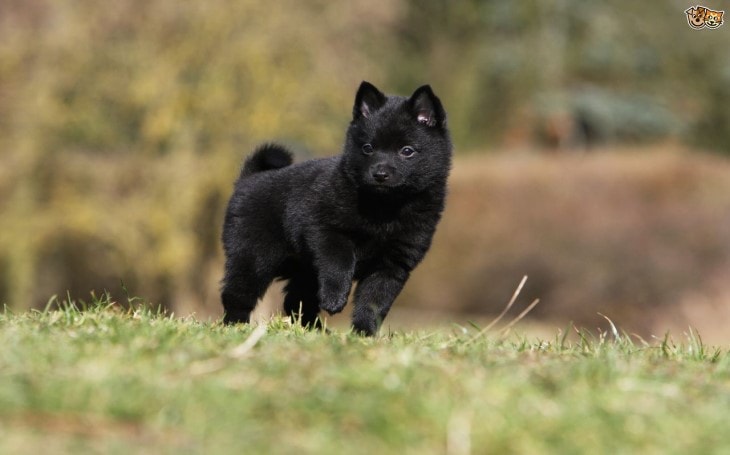Schipperke Dog Breed Information
| Country of Origin | Belgium |
| Nicknames and Other Names | Spitzke Spits Spitske |
| Scientific Name | Canis lupus familiaris |
| Breed Type | Purebred |
| Group | Non-sporting Group Companion Group Herding Group |
| Bred For | Herding cattle |
| Size | Small-sized |
| Recognized By | FCI, UKC, AKC, NZKC, KC, CKC, ANKC |
| Life Span | 12-14 years |
| Ideal Weight | 10-16 pounds (male and female) |
| Ideal Height | Male: 11-13 inches Female: 10-12 inches |
| Fur Type | Medium length, ruff, double-coat, the harsh outer coat, soft undercoat |
| Common Colors | Black |
| Markings | White markings |
| Availability | Moderately available |
| Achievements | None |
| Suitable for Apartments | Moderately Yes |
| Used in World War | Used as a messenger in World War II |
| Most Similar To | American Eskimo Dog |
Schipperke is a fearless, devoted and protective dog breed who make good watchdogs and will never step back to protect their family.
Origin & History Of Schipperke
The Schipperke is an old Belgian breed whose history dates back to several hundred years ago. These dogs first mentioned by a monk in the 1400s and in 1690s the guild workers of Brussel held a show promoting this breed.
These Belgian soon earn popularity on the barges and got its name Schipperke, which means “little captain”. These dogs were even popular with the tradesmen as well and often called the “canal boat dog.”
The Schipperke was owned by Queen Marie Henriette, the wife of Leopold II and fell in love with these small dogs. And soon after that their popularity increases and quickly spread to England as well.
In 1885, Walter J. Comstock imported these dogs to America and in 1929, the Club Of America was established.
Are They Child-Friendly?
Schipperkes are friendly with children and will enjoy playing with them as long as your child’s energy holds out. If raised together, they can be best friends for your child including toddlers.
Temperament, Personality, And Behavior
The temperaments of Schipperke are curious, alert, confident and independent. They are very lively dogs who never get bored and face everything interestingly around them. These dogs always prepared themselves to protect their families and property.
Because of their protective nature, they are always reserved around strangers, so if you want a dog who will love everyone on sight, then Schipperkes is definitely not for you.
Schipperkes Dog Breeds are independent breeds with a mind of their own. They like to do things in their own way and unless you are not able to establish the leadership they will try to ignore you.

Image Via Dogtime
The Schipperke behaves dominantly and can be aggressive around non-canine pets so while interacting with them with other pets, socialization should be conducted.
They are highly intelligent breeds and require activities to keep them occupied to prevent behavioral problems such as excessive barking, chewing and digging.
Trainability
When it comes to training they tend to become stubborn and because of their confident and independent nature training them can be challenging without the help of an experienced trainer. For their training, they require a fenced-in backyard and must be kept on a leash when not confined.
The Schipperkes barks early and often at anything that is not ordinary. Socialize them early from their puppyhood and teach them to obey commands to quiet down.
Facts
Quick facts about Schipperkes are:
- They are tailless dogs
- Their face resembles
fox - They are not trustworthy breeds
Health Issues
| General Health | Healthy |
| Common Health Issues | Obesity, Bloat, Hip Dysplasia, Progressive Retinal Atrophy, Patellar Luxation |
| Hypoallergenic | No |
| Vaccination Required | Rabies, Canine Distemper, Canine Parvovirus, Canine Parainfluenza, Leptospirosis, Kennel Cough, Canine Coronavirus |
| Shedding | Moderate Shedder |
| Drooling | Low Drooler |
| Grooming | Easy and Minimal Grooming Required |
| Weight Gain Potential | High |
| Separation Anxiety | High Chance |
| Allergies | None |
| Diets and Supplements | Protein: 23% Fat: 8% Probiotics Multivitamins Glucosamine Fish Oil |
The Schipperkes has an average lifespan of 13 to 16 years, they may suffer from minor problems like:
- Epilepsy: an inherit a disorder that causes liver disease, kidney failure.
- Legg- Perthes Disease: involves spontaneous degeneration of the head on the femur bone, located in the dog’s hind.
- Hip Dysplasia: a common skeletal condition, more common in large dogs.
- Progressive Retinal Atrophy: a disease that can cause blindness.
Color
Schipperkes are found in six color, which include:
- Black
- Apricot
- Chocolate
- Cream
- Black & Tan
- Blue
Puppies

The Schipperkes dogs give birth up to 4-6 puppies at a time. Their price usually depends on their breeding, they usually cost anywhere from $800-&1,200.
Which Dogs Are They Similar To?
Dogs similar to Schipperkes are:
Visit Doglime for more dog breed information and their behavior.
Tags










